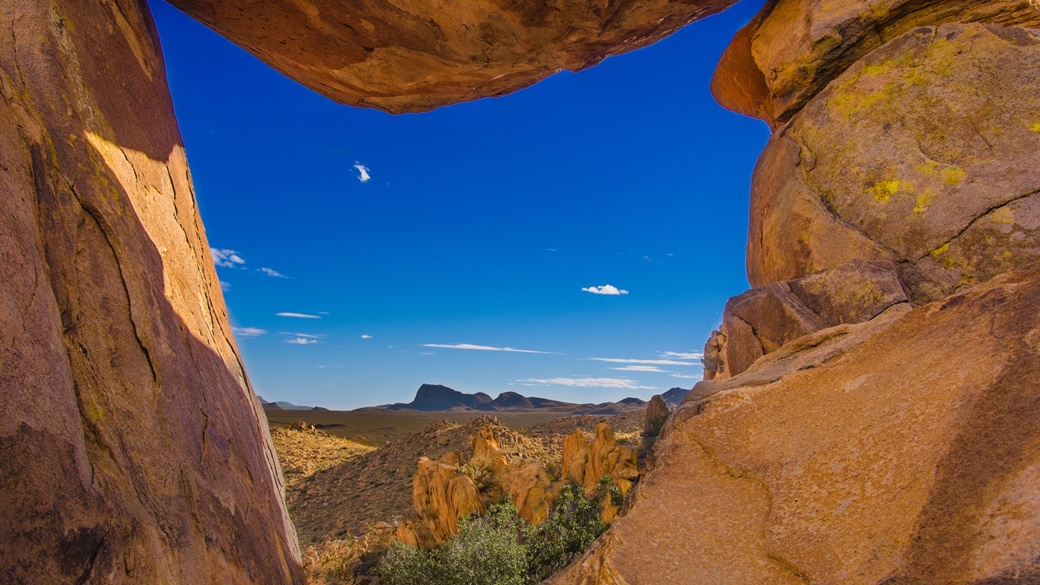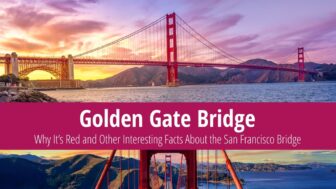One of the largest and least visited parks is Big Bend National Park in South Texas on the border with Mexico. The desert area is not only dominated by rock formations, but also by the valley of the Rio Grande River.

Table of Contents
Big Bend National Park Information
Big Bend National Park is located in the southwestern part of Texas near the border with Mexico. It is comprised of desert, mountains stretching into Mexico, and the Rio Grande/Río Bravo River, which delineates the border between the two countries. The park’s name, Big Bend, originates from one of the bends in the river.
The park spans an area of 1,252 sqmi. Big Bend was visited by 581,220 people in 2021. Big Bend National Park was officially established on June 12, 1944.
The highest point in the park is Emory Peak with an elevation of 7,825 ft, while the lowest is the Rio Grande at 1,716 ft. Although most of the park is desert, there are over 1,200 species of plants, primarily cacti. Animals are not very visible in the daytime, but when they do appear, you are likely to see mountain lions, black-tailed jackrabbits, tarantulas, roadrunners, golden eagles, coyotes, collared peccaries, or black bears.
Numerous movies have been filmed in Big Bend National Park, including Boyhood and No Country For Old Men.
What to See and Do in Big Bend National Park
The main attraction of Big Bend National Park is the rock formations scattered across the desert, often surrounded by water from the Rio Grande. The park is easily navigable thanks to 99 mi of paved roads, the most popular being the 6 mi Chisos Basin Road, the 30 mi Ross Maxwell Scenic Drive, and the 21 mi road connecting Panther Junction to Rio Grande Village. The former in particular, at a place called The Window, offers spectacular views of the entire park.
Big Bend National Park has 150 mi of trails, which are divided into desert, mountain, and river trails. They also vary in terms of elevation, which ranges from 1,801 ft to 7,831 ft.
🏜️ Desert Trails
- Chihuahuan Desert Nature Trail: This easy, 2,625 ft round trip trail offers a beautiful view of the typical Chihuahuan Desert environment.
- Chimneys Trails: This moderately challenging trail of just under 5 mi features several stone chimneys.
- Devil’s Den: The Devil’s Den is a challenging 6 mi trail that leads to a massive limestone canyon.
- Grapevine Hills Trail: This easy 2 mi trail leads to a group of balanced rocks in the heart of the Grapevine Hills valley.
- Lower Burro Mesa Pour-off: This easy 1 mi trail leads to the base of the Burro Mesa channel, which floods with water annually in the summer.
⛰️ Mountain Trails
- Boot Canyon Trail: This challenging, 3 mi trail runs from Pinnacles Pass to the South Rim. During the hike, enjoy views of the Chisos Mountains.
- Chisos Basin Loop Trail: This loop trail less than 2 mi long winds through a forest where American black bears and mountain lions thrive.
- Emory Peak: This highly challenging 11 mi trail leads to the top of the park’s highest mountain. The 360° views are unforgettable.
- Lost Mine Trail: This moderately challenging trail, less than 5 mi long, is suitable for those interested in exploring the flora and fauna of the Chisos Mountains. The trail offers beautiful views of Pine Canyon and the Sierra del Carmen in Mexico.
- Window Trail: A 6 mi trail starting at the Chisos Basin Trailhead leads through Oak Creek Canyon to the desert, offering a wonderful view of the surrounding mountains.
🏞️ River Trails
- Boquillas Canyon Trail: This short, 2 mi trail leads to a peak overlooking the flow of the Rio Grande.
- Hot Springs Canyon Trail: This 6 mi trail connects Daniel’s Ranch and the hot springs, also known as Hot Springs. The trail offers good views of the Rio Grande River and the Chisos and Del Carmen Mountains, but it can be quite a challenge in the summer.
- Rio Grande Village Nature Trail: This very short and easy 1 mi trail is great for bird watching and observing sunsets.
- Santa Elena Canyon Trail: This 2 mi trail leads to the base of Santa Elena Canyon. Be careful – it is inaccessible after Terlingua Creek floods.
Paddlers can experience the canyon, which reaches depths of up to 1,499 ft, from a unique perspective by running down the Rio Grande. This adventure can be planned as a half-day or multi-day trip.
For those interested in exploring Big Bend Park in more depth, ranger-led programs are available. These programs are free and provide a wealth of information about the park’s history, current conditions, and noteworthy locations.
Big Bend is an excellent location for stargazing, boasting the lowest smog levels of the lower 48 states.
When to Visit Big Bend National Park
Big Bend National Park is open year-round, 24 hours a day. However, if you plan to purchase your entrance fee on site, be sure to arrive between 9am and 4pm.
Since Big Bend is located in the desert, summer is not the most ideal time to visit the park due to high temperatures. The hottest months are May and June, when temperatures can reach up to 100 °F. Starting in July, there is an increase in rainfall, which leads to slightly cooler temperatures.
Spring and autumn offer more moderate temperatures, averaging around 81 °F during the day. In the spring, a mild breeze can be expected, while in autumn, rain showers persist until October.
Winter, somewhat surprisingly, is an excellent time to visit Big Bend National Park. Daytime temperatures remain moderate around 50 °F–55 °F and just above freezing at night. Experiencing snow and frost is not uncommon in the park.
Average Temperatures and Visitor Numbers in Big Bend National Park
Average temperatures in Big Bend National Park are based on data from the central Panther Junction station. Visitor counts are averages from 2017-2021, with data provided by the National Park Service.
| Max Temp | Min Temp | Precipitation Days | Visitors | Popularity | |
|---|---|---|---|---|---|
| January | 63 °F | 37 °F | 1.8 | 36 974 | 🟨🟨 |
| February | 68 °F | 43 °F | 1.4 | 43 107 | 🟨🟨 |
| March | 75 °F | 48 °F | 1.7 | 75 803 | 🟥🟥🟥🟥 |
| April | 84 °F | 55 °F | 2.3 | 50 457 | 🟧🟧🟧 |
| May | 90 °F | 63 °F | 5.2 | 40 890 | 🟨🟨 |
| June | 95 °F | 70 °F | 7.2 | 23 445 | 🟨🟨 |
| July | 93 °F | 72 °F | 8.4 | 21 050 | 🟩 |
| August | 91 °F | 72 °F | 8.6 | 17 373 | 🟩 |
| September | 86 °F | 64 °F | 7.0 | 21 999 | 🟩 |
| October | 81 °F | 57 °F | 4.3 | 37 997 | 🟨🟨 |
| November | 72 °F | 46 °F | 1.8 | 49 667 | 🟧🟧🟧 |
| December | 63 °F | 39 °F | 2.0 | 43 980 | 🟨🟨 |
Big Bend National Park Entrance Fees
The entrance fee for Big Bend National Park is $30, which covers all persons in a single vehicle for a maximum stay of 7 days. Entry for those on a motorcycle costs $25 for the entire group. Pedestrians are charged $15.00 per person. Only card payments are accepted; cash is not an option.
For visitors planning to see multiple national parks on a single trip, the America the Beautiful pass is recommended. This pass grants entry to all USA national parks and monuments for a year from the first use. It is priced at $80.
Getting to Big Bend National Park
Because Big Bend National Park is located in a relatively remote area, it’s highly advised to have access to a vehicle, either your own or a rental. Public transportation options are limited, with only Greyhound providing service to the nearby town of Alpine, about 62 mi away.
For your convenience, here are the distances, estimated driving times, and suggested routes from various nearby cities:
| Starting Point | Distance | Drive Time | Route |
|---|---|---|---|
| Albuquerque | 563 mi | 9 hours 40 minutes | View Route |
| Dallas | 587 mi | 9 hours 30 minutes | View Route |
| El Paso | 337 mi | 6 hours | View Route |
| Los Angeles | 1,140 mi | 18 hours | View Route |
| San Antonio | 457 mi | 7 hours 30 minutes | View Route |
Parking spaces are available at the visitor center.
Big Bend National Park Lodging
🏨 Hotels
Accommodation can be booked in close proximity to Big Bend National Park in the town of Terlingua, which offers several hotels in various price ranges. Additional hotels and motels are situated in the town of Alpine, near the I-90 freeway.
⛺ Campsites
Overnight stays are also available in the park, where three campgrounds are set up:
- Chisos Basin Campground
This year-round campground, located at an elevation of 5,400 ft above sea level, offers 60 tent sites. It features restrooms, drinking water, picnic tables, and grills, and charges $16.00 per site per night. The campground is surrounded by rocks and is near some of the most popular hiking trails. - Cottonwood Campground
Situated in a shaded desert oasis between Santa Elena Canyon and the historic Castolon area, the campground offers 24 campsites. The cost for a night’s stay at an elevation of 2,169 ft is $16.00. - Rio Grande Village Campground
The campground, at 1,850 ft elevation, is adjacent to the Rio Grande River and offers up to 100 campsites.
Sites at all campgrounds can be reserved in advance at Recreation.gov.
Tips and Advice Before Visiting Big Bend National Park
ℹ️ Visitor Center
Starting your park tour at the visitor center is recommended, where you can learn more about the park, view exhibits, and purchase souvenirs. There are several centers:
- Panther Junction Visitor Center
The main visitor center, located at park headquarters, offers interactive exhibits about the park’s geology, among other things, and souvenirs for purchase. It is open year-round, every day from 9 a.m. to 5 p.m. - Chisos Basin Visitor Center
Located in the Basin area, it is open year-round from 8:30 a.m. to 4 p.m. (closed for lunch) - Castolon Visitor Center
Located in the historic La Harmonia building, it houses a small museum focused on the region’s colorful past. It is open only from November to April, from 10:00 to 16:00. - Persimmon Gap Visitor Center
A small visitor center at the northern edge of the park, open from November through April from 9:30 a.m. to 4 p.m. - Rio Grande Village Visitor Center
Open seasonally from November through April from 8:30 a.m. to 4 p.m., the center is located adjacent to Rio Grande Village.
👍 Good to Know
Big Bend National Park constitutes 118 mi of the border between the USA and Mexico. You can cross into Mexico at the Boquillas border crossing, but be sure to carry your passport.
Maintaining a hydration regime is essential when visiting the park, especially during the summer months when dehydration can occur quickly due to the extremely high temperatures. Applying sunscreen, wearing sturdy shoes, headwear, and sunglasses is also advisable. Don’t forget to bring several layers of clothing if you plan to stay overnight, as it can get quite cold at night.
Photos of Big Bend National Park









US National Parks
- National Parks of the USA – Map, List and Annual Pass
- America the Beautiful Pass 2025 – How It Works, Cost & Parks
- Timed-Entry Reservation for US National Parks (2025 GUIDE)
Travel Guides to USA National Parks

 10 Best Photo Places in the USA
10 Best Photo Places in the USA




Contribute with Your Question or Personal Experience